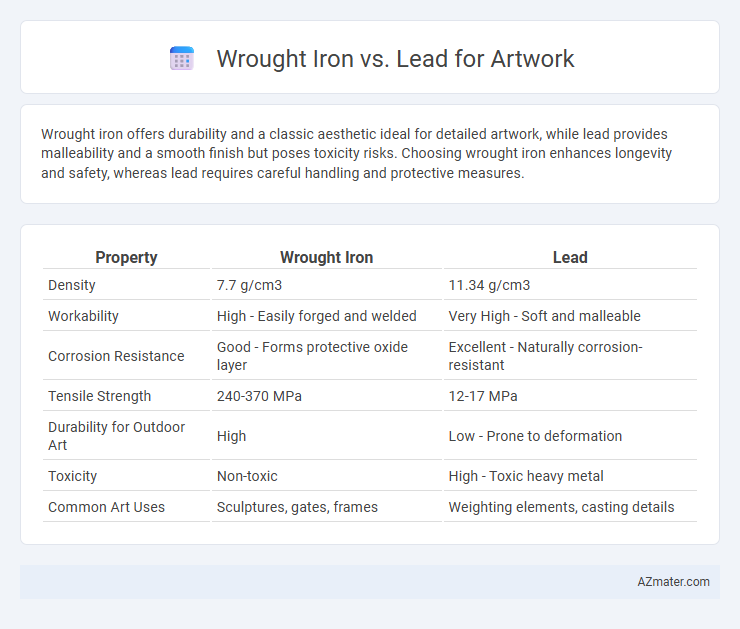Wrought iron offers durability and a classic aesthetic ideal for detailed artwork, while lead provides malleability and a smooth finish but poses toxicity risks. Choosing wrought iron enhances longevity and safety, whereas lead requires careful handling and protective measures.
Table of Comparison
| Property | Wrought Iron | Lead |
|---|---|---|
| Density | 7.7 g/cm3 | 11.34 g/cm3 |
| Workability | High - Easily forged and welded | Very High - Soft and malleable |
| Corrosion Resistance | Good - Forms protective oxide layer | Excellent - Naturally corrosion-resistant |
| Tensile Strength | 240-370 MPa | 12-17 MPa |
| Durability for Outdoor Art | High | Low - Prone to deformation |
| Toxicity | Non-toxic | High - Toxic heavy metal |
| Common Art Uses | Sculptures, gates, frames | Weighting elements, casting details |
Introduction to Wrought Iron and Lead in Art
Wrought iron and lead are distinct materials frequently used in artwork, each offering unique properties that influence artistic expression. Wrought iron, known for its malleability and durability, is commonly utilized in sculptures, gates, and ornamental designs due to its ability to be shaped into intricate patterns and its resistance to corrosion. Lead, prized for its softness and ease of casting, is often employed in stained glass windows and small detailed pieces, providing artists with versatile shaping options and a distinctive texture.
Historical Significance of Wrought Iron Artwork
Wrought iron artwork holds profound historical significance due to its widespread use in intricate architectural details, gates, and decorative objects from the medieval period through the 19th century. Its durability and malleability allowed artisans to create highly detailed, enduring pieces that symbolize craftsmanship and cultural heritage across Europe and America. In contrast, lead was primarily used for stained glass windows and smaller sculptures, lacking the extensive structural and ornamental role that defines wrought iron's historical legacy in art.
Lead in Artistic Tradition: A Brief Overview
Lead has played a significant role in artistic tradition due to its malleability and low melting point, making it ideal for detailed casting and intricate designs in sculpture and stained glass windows. While wrought iron offers durability and strength for large outdoor installations, lead's softness allows artists to create delicate, refined pieces with subtle textures. Despite health concerns with lead usage, historical artworks demonstrate its importance in decorative arts and religious iconography across various cultures.
Physical Properties: Wrought Iron vs Lead
Wrought iron exhibits high tensile strength, malleability, and corrosion resistance, making it suitable for durable and intricate artwork, while lead is softer, denser, and more malleable but prone to oxidation and deformation over time. Wrought iron's fibrous grain structure provides enhanced toughness and weldability compared to lead's low melting point and heavy weight, which influence artistic techniques and longevity. These physical properties determine the choice between wrought iron's rigidity and longevity versus lead's ease of shaping yet susceptibility to damage in art pieces.
Artistic Techniques: Sculpting with Iron and Lead
Sculpting with wrought iron involves techniques such as forging, welding, and hammering to create intricate, durable structures with a textured surface ideal for large-scale artworks. Lead, known for its softness and malleability, allows artists to employ methods like casting, carving, and embossing, enabling fine detail and smooth finishes in smaller sculptures. Artists often choose wrought iron for strength and industrial aesthetics, while lead offers versatility for delicate, detailed designs or layered relief work.
Durability and Longevity in Art Installations
Wrought iron exhibits superior durability in art installations due to its high tensile strength and resistance to deformation, making it ideal for structural elements that require longevity. Lead, while malleable and easy to shape, is prone to corrosion and softening over time, reducing its suitability for outdoor or long-term artworks. The inherent robustness of wrought iron ensures extended lifespan and minimal maintenance, securing the integrity of art pieces exposed to environmental stress.
Safety and Health Considerations for Artists
Wrought iron is a safer material for artwork compared to lead, as it does not pose significant toxicity risks during handling or finishing processes. Lead exposure can cause harmful health effects such as lead poisoning, neurological damage, and respiratory issues, making it essential for artists to use protective gear and work in well-ventilated environments when using this material. Proper disposal and cleanup are critical when working with lead to prevent contamination and long-term health hazards.
Aesthetic Appeal: Visual Characteristics Compared
Wrought iron art features intricate textures and natural patinas that develop a rustic, timeless charm, while lead offers a smooth, pliable surface ideal for detailed sculpting and stained glass framing. The dark, matte finish of wrought iron contrasts with lead's softer, muted gray tones, enhancing different visual narratives in artwork. Both materials hold unique aesthetic appeal, with wrought iron emphasizing durability and bold lines, and lead highlighting delicate contours and subtler shading.
Environmental Impact: Sustainability of Materials
Wrought iron offers greater sustainability in artwork due to its recyclability and long lifespan, minimizing resource depletion and waste. Lead poses significant environmental risks, including toxicity and difficulty in recycling, which contribute to soil and water contamination. Choosing wrought iron supports eco-friendly practices by reducing hazardous waste and promoting sustainable material use.
Choosing Between Wrought Iron and Lead for Art Projects
Choosing between wrought iron and lead for art projects depends on factors like durability, malleability, and safety. Wrought iron offers high strength and corrosion resistance, ideal for outdoor sculptures, while lead provides excellent pliability for detailed work but poses toxicity risks requiring careful handling. Consider the environmental exposure and desired intricacy to select the most suitable material for lasting, safe, and visually appealing artwork.

Infographic: Wrought iron vs Lead for Artwork
 azmater.com
azmater.com